October 20: Inventing "the Maya"
Why and how did “the Maya” become an object for archaeological, historical, and ethnographic study? What are the ongoing effects and implications of pan-Mayanism, for both the past and the present?

October 20: Agenda
In this week's synchronous class meeting, we will:
1. Hear from Allie Scholten, who will introduce the UChicago Visual Resources Center and discuss how the VRC can support your final Shorthand projects for the course
2. Discuss the week's readings and videos (don't forget to post to the week's Canvas discussion forum by 12 PM!)
3. Complete a Breakout Group "Maya in Unexpected Places" activity, an exploration of how Maya culture—from Classic-period hieroglyphs to contemporary clothing—has been appropriated and employed, sometimes in suprising ways.
Readings for Discussion
Although I originally intended these readings to follow directly on the heels of our discussions about "discovery" from Week 2, I shifted them to allow for Professor Houston's visit on October 13. You'll quickly see, however, that both amateur and professional fascinations with ancient, colonial, and contemporary indigenous peoples have profoundly shaped the heavy baggage that the term "Maya" carries. (In some cases, you'll also recognize names familiar from Week 2 as perpetrators of particular notions of "the Maya"). The readings for this week not only question what we mean by "the Maya," but also trace out some of the possible cultural, political, and linguistic impacts of that designation when used by different people and in different contexts.
1. Les Mitchel, Maya are People (1951) – Part 2 (Optional: Part 1)
In his memoir Triste Tropiques, French anthropologist Claude Lévi-Strauss describes his travels in the 1930s, which inlcude visits to the Brazilian Amazon and European colonies in the Caribbean and India. In recounting his arrival in the city of Lahore, in what is now Pakistan, Lévi-Strauss recalls his conflicted feelings:
"Where could it be, the old, the authentic Lahore? To get to it, at the far end of the badly laid-out and already decrepti suburbia, one had to cross a lengthy bazaar-area, in which were to be found cosmetics, medicines, imported plastic materials, and shoddy jewellry—made, this last, by the operation of a mechanical saw on gold the thickness of white lead...I should have liked to live in the age of real travle, when the spectacle on offer had not yet been blemished, contaminated, and confounded; then I could have seen Lahore not as I saw it, but as it appeared to Bernier, Tavernier, Manucci...There's no end, of course, to such conjectures. When was the right moment to see India? At what period would the study of the Brazilian savage have yielded the purest satisfaction and the savage himself been at his peak? Would it have been better to have arrived at Rio in the eighteenth century, with Bougainville, or in the sixteenth, with Léry and Thevet? With every decade that we travelled further back in time, I could have saved another costume, witnessed another festivity, and come to understand another system of belief. But I'm too familiar with the texts not to know that this backward movement would also deprive me of much information, many curious facts and objects, that would enrich my meditations. The paradox is irresoluble: the less one culture communicates with another, the less likely they are to be corrupted, one by the other; but, on the other hand, the less likely it is, in such conditions, that the respective emissaries of these cultures will be able to seize the richness and significance of their diversity."
The paradox described by Lévi-Strauss is one that arises time and again in the idea, the practice, and the products of anthropological research: the process of describing, capturing, and/or conserving diverse material and immaterial cultures cannot take place without impacting its object(s) being studied.
The film below, produced by adventurer-filmmaker Les Mitchel in 1951, is both a striking visual example of the immediate impact of the observer (in this case, the documentarian), the desire to "protect" the observed from further "outside" influences, and of the ways in which ethnographic writing and images can not only dictate what is considered "authentic" culture, but also come to define expressions of national identity (for both foreigners and locals). Optional: Part 1 of Mitchel's film can be found here.
Les Mitchel, Maya are People (Part 2), 1951
Maya are People is one of many nontheatrical films about indigenous Mexico, pre-Columbian civlizations, and folk art produced during the 1950s. To name just a few others: The Aztecs (Coronet Films, 1955), Doña Rosa: Potter of Coyotepec (Orville Goldner, 1959), Fisher Folk of Lake Pátzcuaro (Ralph Adams, 1951), Pottery Workers of Oaxaca (Ralph Adams, 1952), Mexican Village Life (Willard Hahn, 1958), and Heritage from Tula (Joseph Ehrhard and Mel Fowler, 1960). These films both reflected and stimulated ideas about indigenous peoples as the epicenter of cultural authenticity, ideas which were not only officially taken up as formulations of Mexican national identity and history, but also embraced by foreign tourists, who responded readily to the promise of a scenic and exotic Mexico.
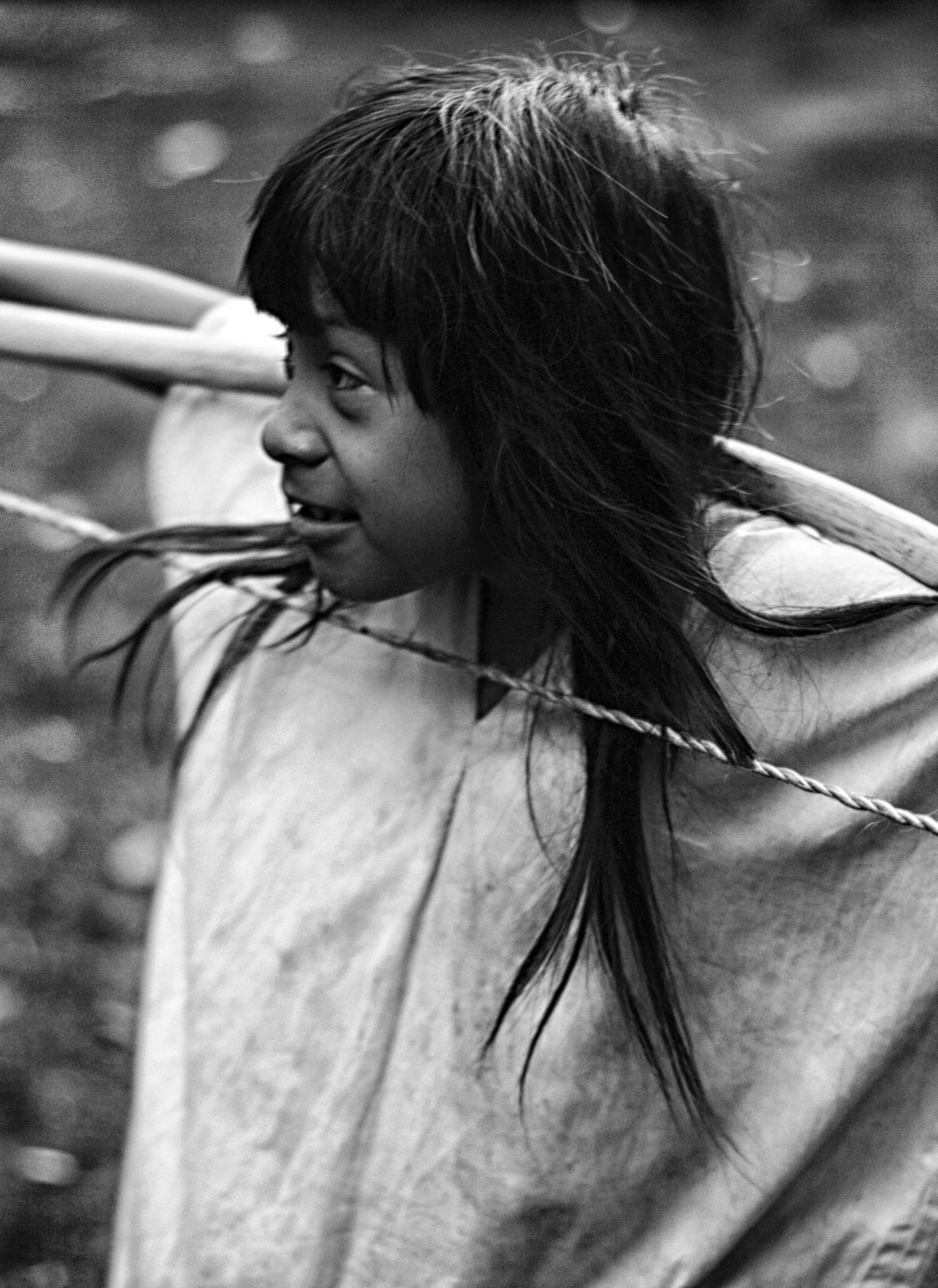
Photograph by Gema Ramon, 2015.
Photograph by Gema Ramon, 2015.
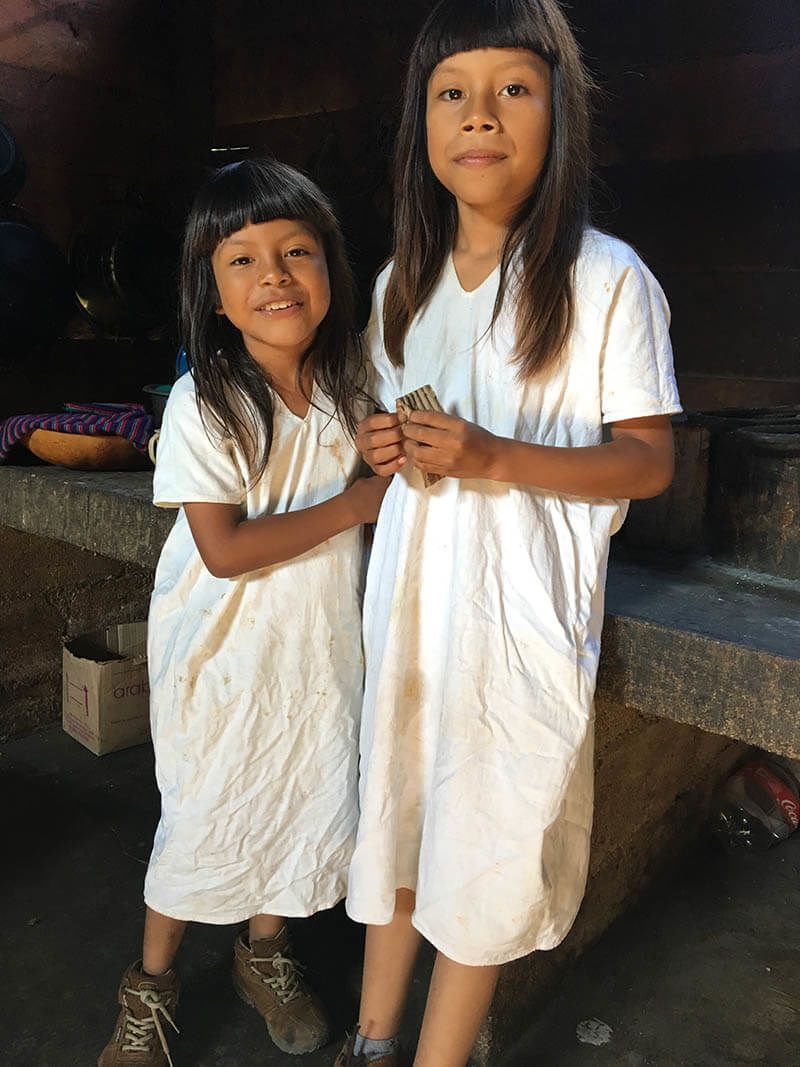
Brothers Bor and Chan K'in Valenzuela at home in the Lacandón community of Mensäbäk, Chiapas, Mexico. Photograph by James D. Nations, 2017.
Brothers Bor and Chan K'in Valenzuela at home in the Lacandón community of Mensäbäk, Chiapas, Mexico. Photograph by James D. Nations, 2017.
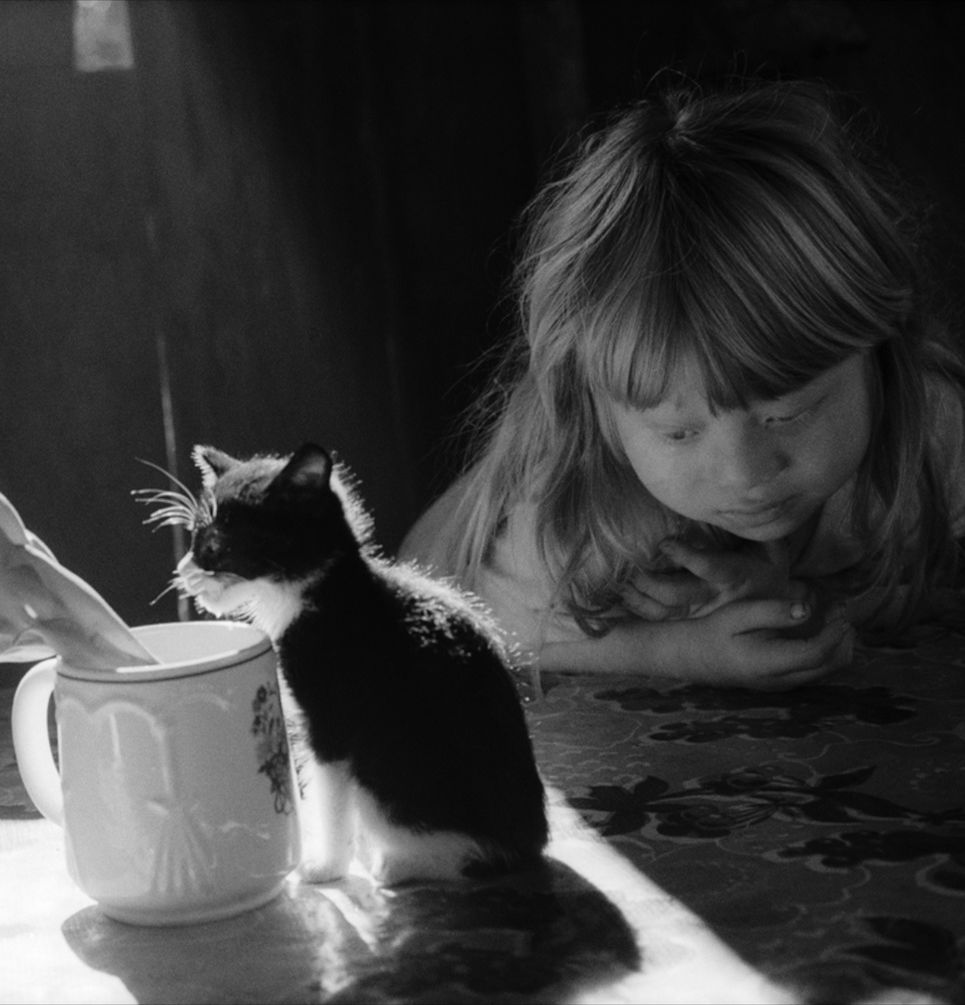
Photograph by Carol Yarrow, date unknown.
Photograph by Carol Yarrow, date unknown.
2. Victor D. Montejo, “Representation via Ethnography: Mapping the Maya Image in a Guatemalan Primary-School Social-Studies Textbook”
Victor Montejo grew up in the Jakaltek Maya village of La Laguna, in the department of Huehuetenango, Guatemala. In addition to his native langauge of Popb'al Ti' (the Jalkatek Mayan language), Montejo learned both Spanish and Latin when he was sent to a Catholic boarding school in Jacaltenango at the age of seven and later attened the Seminary of San José in Sololá on a scholarship. After three years of seminary and studying to become a school teacher in Antigua, Guatemala, Montejo returned to Jacaltenango and taught primary school in the village of Yinhch'ewex and other Jakaltek communities. In 1982, Montejo came to the United States on a tourist visa to work on a translation of a Jakaltek oral narrative called El Q'anil: The Man of Lightning. While Montejo was in the United States, his wife sent word that he could not return to Guatemala, that the army and civil patrols had been looking for him.
Unable to stay in the United States and unable to return to Guatemala, Montejo moved to a refugee camp in Guadalupe Victoria, Mexico. While in the camp, Montejo began writing about the massacres and other events that forced him and thousands of other Guatemalans into exile. Montejo's manuscript made its way into the hands of Victor Perera, a Guatemalan writer living in the United States, who thought it should be published in Spanish and in English. With the help of Perera, Kaufman, and others, Montejo applied for an H-1 visa (for people with special skills) and returned to the United States in 1984. Montejo's wife and children were able to join him later that year (two years after he had last since them).
Montejo began to study English and, in his words, "to dream of studying at a university in the United States." He applied to the SUNY-Albany, a university with a strong Maya Studies program and generous scholarships, where he completed his bachelor's and master's degree in anthropology, and later moved to the University of Connecticut to complete a doctoral degree in anthropology. Montejo thus has a relatively rare perspective as someone who has both a Maya upbringing and a Western education. Montejo writes:
"Indigenous people have always complained that anthropologists do not listen to them, that anthropologists have represented them as 'primative' or 'a minority,' or 'backward,' or even just as 'informants.' As Mayas, we find it hard to deal with the academic world, because if we tell the 'experts' what is Mayan, they are reluctant to listen. Instead they find it more scienctific (or perhaps more comfortable?) to tell us what it is to be a Maya or how to define Maya culture. We know that there are many perceptions of any situation. We know that we do not possess the sole truth. But it is our culture that is at stake. We regret that our views are not taken seriously and that we are continually placed in the position of being listeners. Our stories and knowledge have been treated as data to be processed into ethnographies by and for the academic interpreters.
In the chapter we're reading for this week, Montejo describes how long-held ideas about the Maya—some of which were invented by Sylvanus Morley and other scholars of the Carnegie Institution—are reproduced again and again in the textbooks assigned to schoolchildren in Guatemala. As you read, take note of what children (both indigenous and non-indigenous) are taught from an early age about Maya history (pre-Columbian and post-contact) and about Maya peoples, as well as the role that Maya archaeology has played and continues to play in either reinforcing or combating some of those ideas.
Access a PDF of Montejo's “Representation via Ethnography: Mapping the Maya Image in a Guatemalan Primary-School Social-Studies Textbook” here.
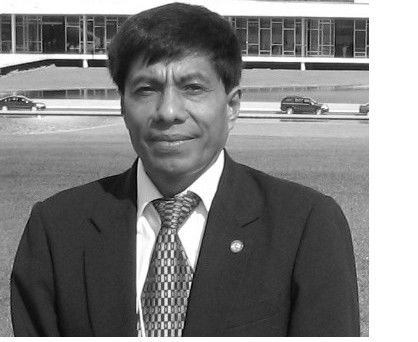
Victor D. Montejo. Photograph from www.victormontejo.com.
Victor D. Montejo. Photograph from www.victormontejo.com.
This map shows the village of La Laguna, where Montejo grew up. If you explore the satellite image, you can get a sense of the topography and density of the department of Huehuetenango.
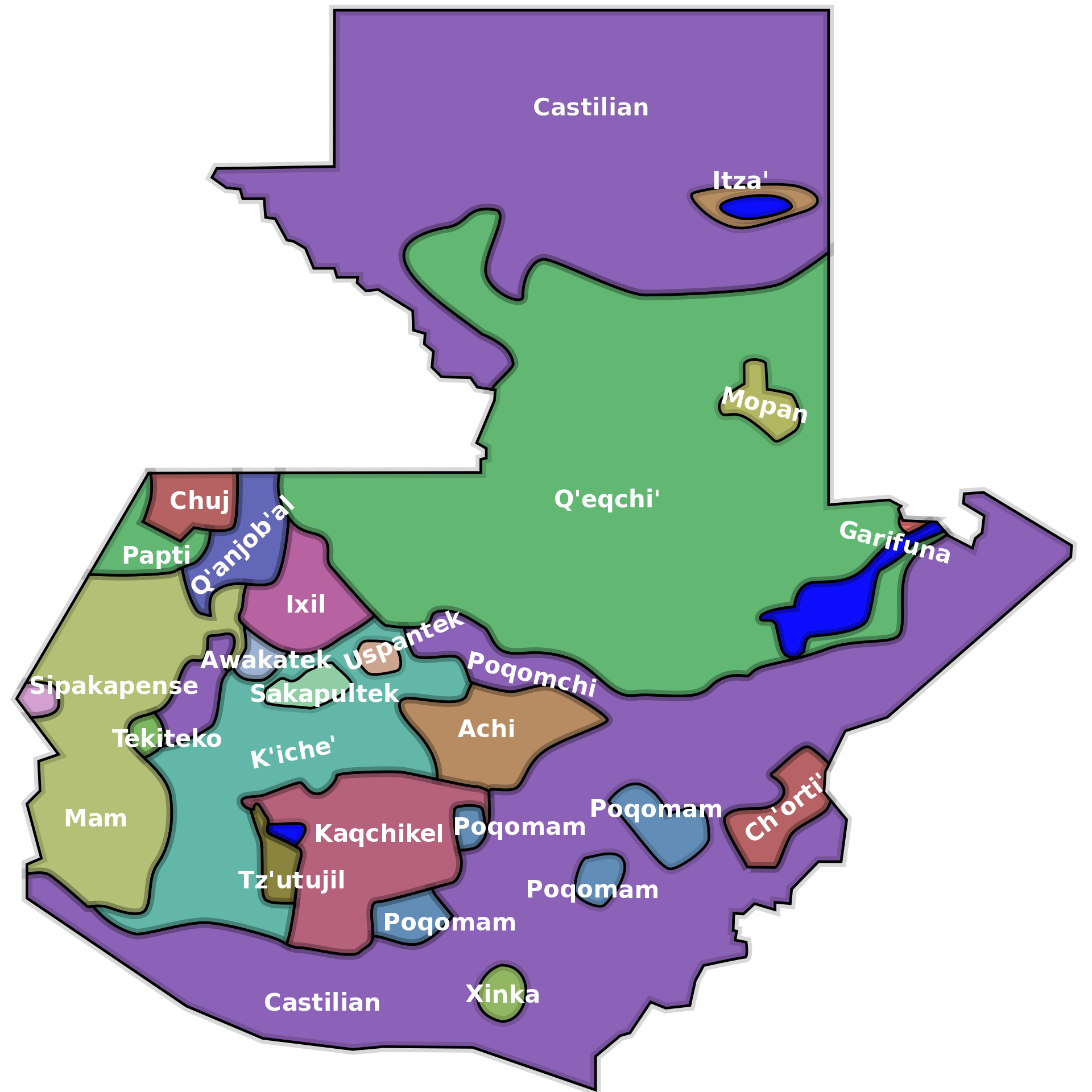
Map of languages of Guatemala, according to the Comisión de Oficialización de los Dialectos Indígenas de Guatemala. Source: Wikipedia.
Map of languages of Guatemala, according to the Comisión de Oficialización de los Dialectos Indígenas de Guatemala. Source: Wikipedia.
The map above shows where different languages are spoken in Guatemala. Like biodiversity, linguistic diversity can be shaped by natural features. Mountains, which limit travel and communication, encourage languages to diverge and develop independently, while rivers tend to facilitate interaction. You can see how in the southwestern region of Guatamala—the highlands—many languages exist. In the northern and eastern lowlands, by contrast, large swathes of the region speak the same language. (These general trends also reflect colonial political strategies and the forced separation and relocation of specific Maya populations).
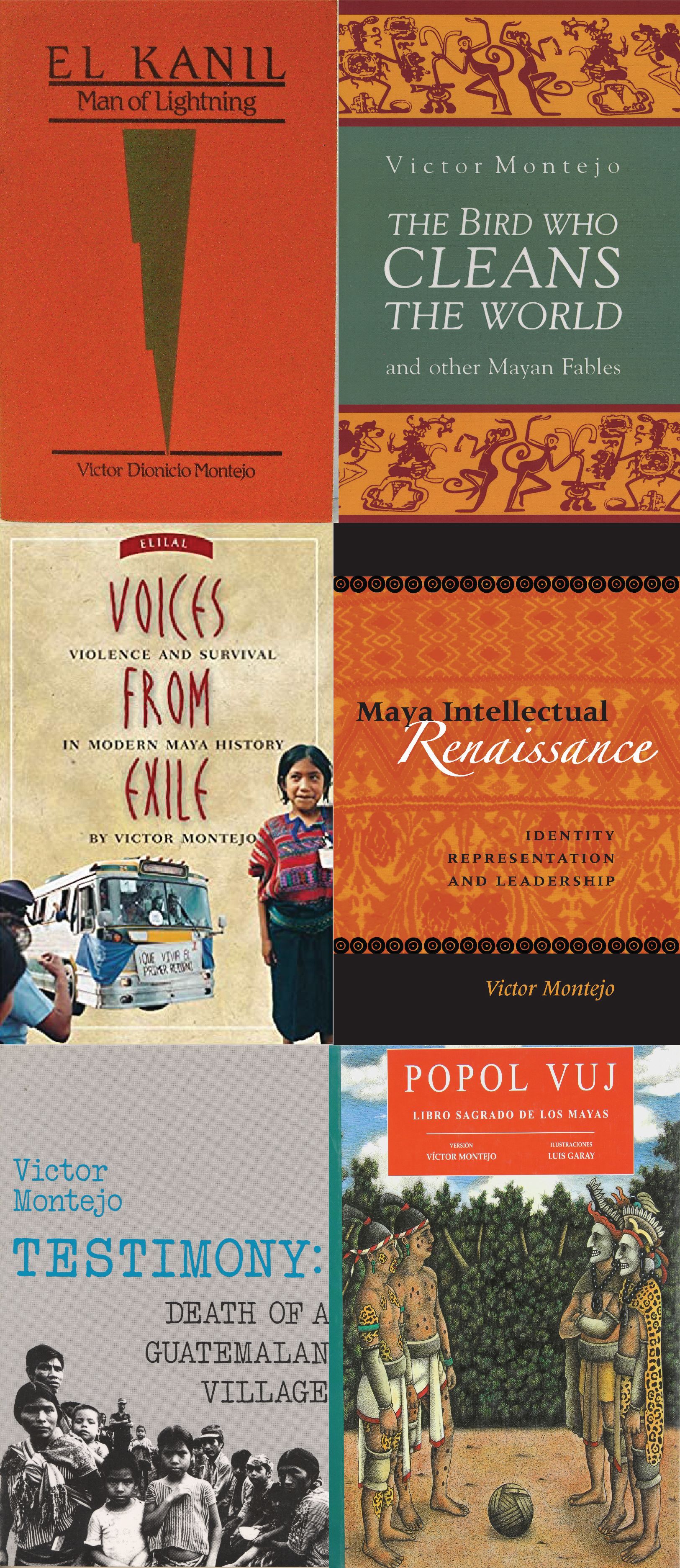
3. Laurie Kroshus Medina, "Commoditizing Culture: Tourism and Maya Identity"
This article tackles some of the same questions raised above by Les Mitchel's early documentary film: Is there such a thing as "authentic" culture? Does interest in a culture—whether on the part of academics or tourists—inevitably affect that culture, thereby impacting the study or experience of it?
Kroshus Medina focuses her ethnography on the village of Succotz, in Belize, nearby to the easily accessible ruins of Xunantunich, where she highlights some of the complexities involved in the notion of a "Maya" identity. Pay particular attention to what "Mayaness" means for the Succotzeños in Kroshus Medina's case study, especially the issues she describes around value and validity.
Kroshus Medina highlights some of the myriad ways that knowledge is lost, gained, created, and/or commodified in Succotz. Thinking about the binary she draws on and critiques between culture as either essential or constructed, how do you understand the reclamation and revitalization of ancient Maya cultural practices (e.g., stone carving, ceramic production) in relation to the generation of contemporary Maya identities? What is positive, what is problematic? (Bear these issues in mind with respect to Mallory Matsumoto's article below as well).
Access a PDF of Laurie Kroshus Medina's "Commoditizing Culture: Tourism and Maya Identity" here.
4. Mallory Matsumoto, “The Stela of Iximche’ in the Context of Linguistic Revitalization and Hieroglyphic Revival in Maya Communities of Guatemala”
This article by Mallory Matsumoto examines the particular case study of the revitalization of ancient Maya hieroglyphic writing at the archaeological site of Iximche', in southern Guatemala. Matsumoto describes a stela erected by a team of Kaqchikel experts at Iximche' on December 21, 2012 to commemorate the ending of the 13th bak'tun cycle (a cycle of 144,000 days in the Maya calendar known as the Long Count).
The Iximche' example is rich and complex: it clearly demonstrates the role of ancient Maya cultural practices (the making and carving of stone stelae and hieroglyphic writing) in affirming a contemporary Maya collective identity, but also highlights the accomodations and adaptations that must be made to reclaim a past that is distant not only temporally, but, in some ways, culturally as well (the Maya hieroglyphic script, for example, seems not to have been used by the pre-Columbian Maya at Iximche').
Access Matsumoto's original article (in Spanish) here or an English translation here.
As you read, consider the role that Mayan languages and cultural practices play in the creation and/or maintenance of a collective cultural identity. Think about the terms that Matsumoto defines in laying out her topic: "revitalization," but also "resurrection" and "reintroduction." What decisions are involved in those processes and what is their result? More broadly, reflect on the various creativities and negotiations involved in reclaiming the past and affirming the present.
Drone footage of the archaeological park at Iximche' in Tecpan, Guatemala.
You can also take a (somewhat clunky) virtual tour of the ruins of Iximche' here (select "Iximche'" from the menu at left).
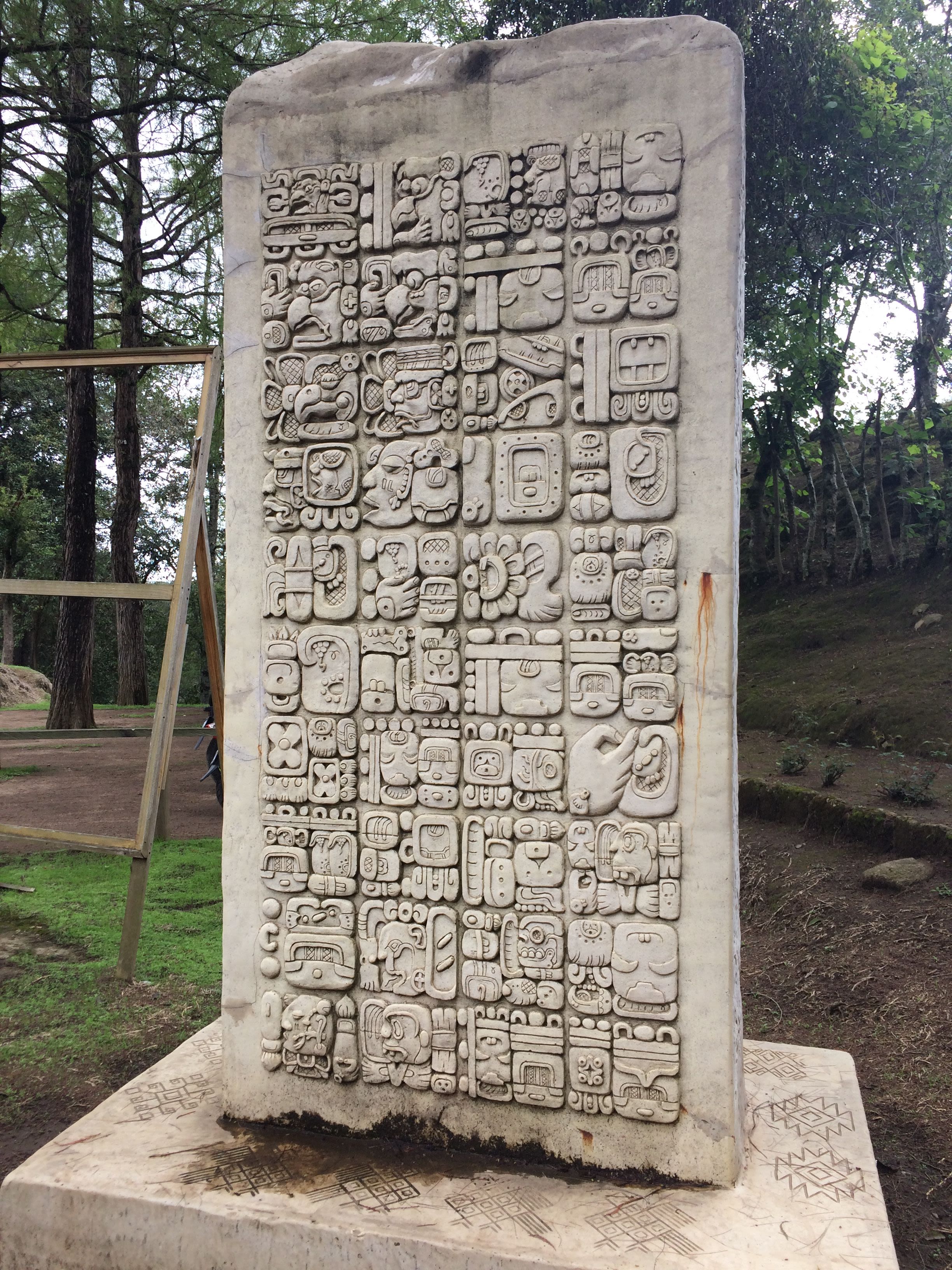
The Stela of Ixchime'. Photograph by Melanie McQueen.
The Stela of Ixchime'. Photograph by Melanie McQueen.
5. Pat Boy and Yazmín Novelo, "Xíimbal Kaaj"
Jesús Pat (Pat Boy) is an artist from Jose María Pino Suárez, a town in Quintana Roo. He is a native speaker of Yukatek Mayan, who describes his work as "Maya rap with conscience." In addition to her music, Yazmín Novelo is a linguist and professor at the Universidad Autónoma de Yucatan, in Merida, Mexico with Yukatek heritage. The video below for "Xíimbal Kaaj" ("People who Walk") was filmed in the town of Timucuy, near Mérida.
The YouTube video below does not include subtitles, but will encourage you to listen to the sounds of Yukatek. You should also watch the video while following along with English subtitles, provided by Google Arts & Culture here. Think about how "Mayaness" is understood and expressed in "Xíimbal Kaaj" (with both words and imagery) in relation to the issues raised by the texts above.
6. Optional: Quetzil E. Castañeda, "'We Are Not Indigenous!': An Introduction to the Maya Identity of Yucatan"
This reading is the introduction to a special issue of The Journal of Latin American Anthropology (which has since become The Journal of Latin American and Caribbean Anthropology), devoted entirely to the topic of "The Maya Identity of Yucatan, 1500-1935: Re-Thinking Ethnicity, History, and Anthropology." Castañeda, an anthropologist, co-edited the issue with historian Ben Fallaw.
Castañeda's introduction (like the issue as a whole) turns more specifically to academic disciplines like anthropology, archaeology, and history to critically evaluate the creation, propagation, and impact of "the Maya" as a singular identity from the sixteenth to the twentieth century, in Yucatan and beyond. As Castañeda explains, the special issue attempts to turn away from the narrow idea of "identity politics" toward "the politics of identity"—to show how identities vary across time and space, are historically and politically unstable, and can hold a range of meanings for what are, in fact, diverse groups of people. The introduction also includes a quick overview of each of the contributions to the journal, which may offer you a useful resource as you decide on a topic for your final Shorthand page.
Note: The "Caste War" comes up several times in Castañeda's introduction. In brief, at the end of the 19th century, indigenous farmers in Yucatan revolted again the hacienda system—the expropriation of public land for private estates following Mexican independence from Spain. The Caste War is a central topic for this themed issue because stark lines were drawn between Maya and non-Maya (European descendants called "Yucatecos"), inlcuding the creation of a new Maya state (officially recognized by the United Kingdom to promote trade) at Chan Santa Cruz (later occupied by the Mexican army to end the war in 1901). The violence lasted over half a century, duirng which more than a quarter of a million people are estimated to have died or been displaced.
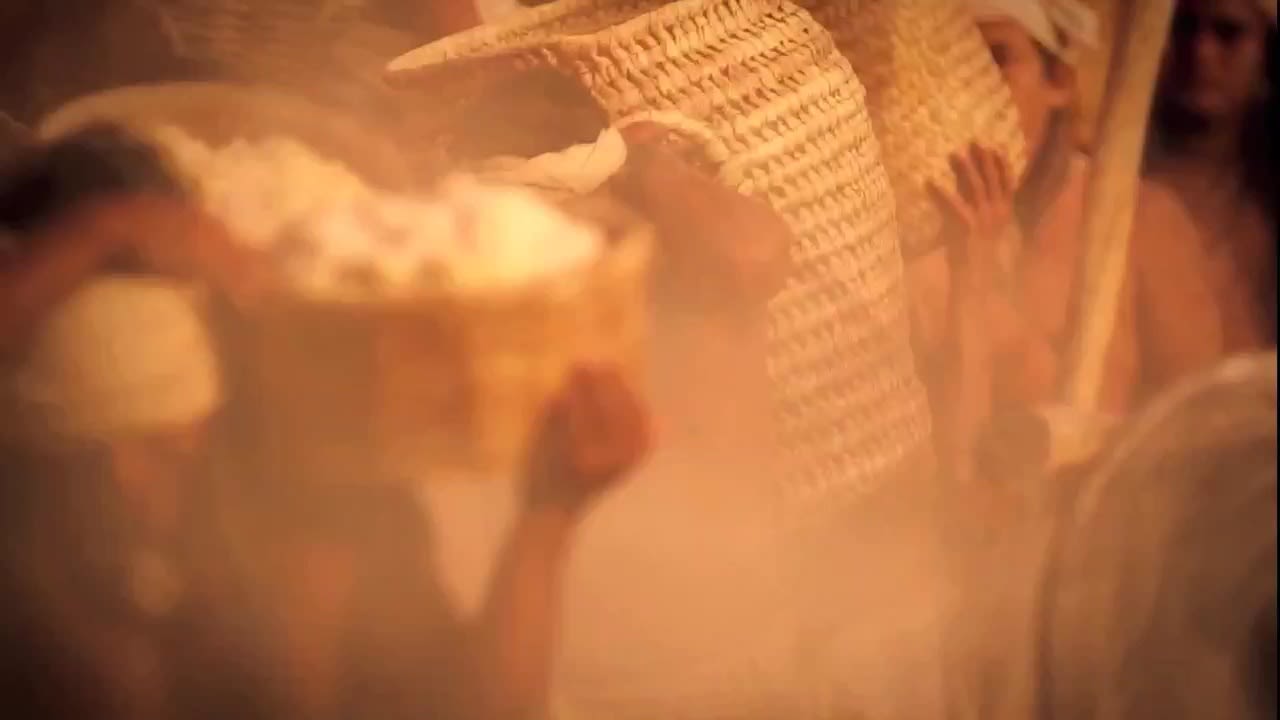
Breakout Group Activity: Maya in Unexpected Places
In this simple activity, you will work with a small group to explore the ways in which "the Maya" and Maya culture (broadly conceived) have been put to sometimes-surprising uses.
Find an example in which aspects of Maya culture or Mayan languages have been employed by or for non-Maya audiences. Whne you have chosen your example, upload a brief description, image, or link to the Breakout Group assignment in the October 20 Canvas module. As usual, be prepared to discuss your example and the reasoning behind your choice with the rest of the class.
A few of my own favorites are included in the media gallery below.





Miss Mexico, Elisa Nájera, dressed as Chichen Itza's El Castillo pyramid during the Miss Universe competition's national costume show in 2008.
Miss Mexico, Elisa Nájera, dressed as Chichen Itza's El Castillo pyramid during the Miss Universe competition's national costume show in 2008.

George Lucas filming Star Wars Episode IV: A New Hope from the top of Temple IV at Tikal, Guatemala.
George Lucas filming Star Wars Episode IV: A New Hope from the top of Temple IV at Tikal, Guatemala.

The heavy metal band Iron Maiden's tour plane, with Mayan hieroglyphs (chosen in consultation with Simon Martin, an epigrapher at the University Museum of the University of Pennsylvania) on the tail.
The heavy metal band Iron Maiden's tour plane, with Mayan hieroglyphs (chosen in consultation with Simon Martin, an epigrapher at the University Museum of the University of Pennsylvania) on the tail.

A 1967 advertisement for "The Mayans" a metaphysical, mail-order self-help group headed by a woman named Rose Dawn, in San Antonio, TX.
A 1967 advertisement for "The Mayans" a metaphysical, mail-order self-help group headed by a woman named Rose Dawn, in San Antonio, TX.
